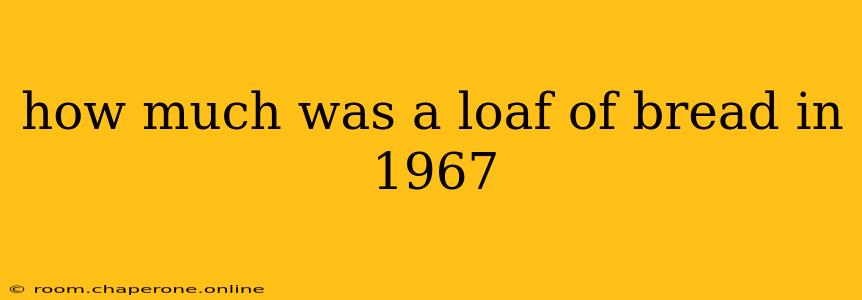The price of a loaf of bread in 1967 offers a fascinating glimpse into the past, reflecting not only economic conditions but also societal shifts. While pinning down an exact figure proves challenging due to regional variations and the types of bread available, we can explore the average cost and contextualize it within the broader economic landscape of the time.
The Average Cost: A Range of Prices
Unfortunately, there isn't a single definitive answer to "How much was a loaf of bread in 1967?" The price fluctuated based on several factors:
- Location: Prices varied across different states and even within cities. Rural areas often had lower costs than urban centers.
- Type of Bread: A simple white loaf would have been cheaper than a more specialized or artisan bread. The availability of different types of bread also varied regionally.
- Store Type: Prices differed between grocery stores, bakeries, and smaller shops.
Considering these variables, a reasonable estimate places the average cost of a loaf of bread in 1967 between 20 and 30 cents. Some sources suggest prices could be slightly lower in certain areas, while others point to higher costs in specific regions or for particular types of bread.
Contextualizing the Cost: The Economy of 1967
To truly understand the value of 20-30 cents for a loaf of bread in 1967, we need to consider the broader economic context. The year 1967 fell within a period of relative economic prosperity in the United States, though the Vietnam War was beginning to exert its influence on the economy.
- Minimum Wage: The federal minimum wage in 1967 was $1.40 per hour. This means a loaf of bread represented roughly 14-21% of an hour's minimum wage earnings.
- Average Income: While average income figures vary based on the source and methodology, a loaf of bread represented a small fraction of the average household's weekly or monthly income.
- Inflation: Using today's inflation calculators, 20-30 cents in 1967 translates to roughly $1.80 to $2.70 in 2024. This demonstrates the significant impact of inflation over time.
Beyond the Price Tag: Social Significance
The cost of bread in 1967 serves as a powerful symbol of a simpler time. It speaks to an era where staple foods were relatively inexpensive and accessible to a larger segment of the population compared to today. The affordability of bread then highlights the considerable changes in the cost of living over the past five decades.
Factors Affecting the Price of Bread Today
The price of bread has significantly increased since 1967. This is a result of multiple factors including:
- Increased production costs: The costs associated with farming, transportation, and processing have all risen.
- Global market fluctuations: The price of wheat, a key ingredient in bread, is subject to global market forces, affecting overall prices.
- Packaging and distribution: Modern packaging and complex distribution networks add to the final cost.
Understanding the past price of bread helps us appreciate the complex economic factors that shape our current cost of living.
Conclusion: A Slice of History
While a precise figure for the price of a loaf of bread in 1967 remains elusive, the approximate range of 20-30 cents provides valuable insight into the economic realities of the time. By comparing this historical price to present-day costs and considering the broader economic context, we gain a deeper understanding of inflation, economic changes, and the evolving cost of living. It's a small slice of history, but one that offers a significant perspective on the past and present.

